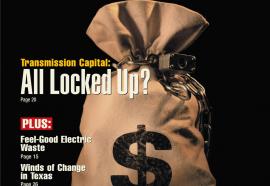Fortnightly Magazine - April 1 2003
Winds of Change in Texas
Rising gas prices spark a rush to wind farms, straining grid capacity and raising larger issues about market design.
When the Public Utility Commission of Texas (PUCT) was drafting rules to encourage the use of renewable energy, it took pains to guard against the chance that power producers would fail to reach the state's target of 400 megawatts (MW) in installed new renewable generation capacity by Jan. 1, 2002. The commission needn't have worried.
Federal Interconnection Standards: Putting DG in a Box
Frontlines
Beware of a national energy crisis that eclipses California's.
It seems rather elementary in an economic downturn to say that generating capacity will easily match demand over the next few years, especially with all the new plants that have been built lately. But what happens to the supply picture when you factor in a possible economic upswing, with continued high natural gas prices, an illiquid wholesale market, and an aging transmission infrastructure?
People
New Hires:
The North American Electric Reliability Council (NERC) promoted Dave Nevius to senior vice president; David Cook to vice president and general counsel; and Don Benjamin to vice president. Nevius has been a vice president at NERC since 1986; Cook has been NERC's general counsel since 1999; and Benjamin has been director of operations since 1985.
Ameren Corp. named Martin J. Lyons vice president. Lyons has been the company's controller since joining Ameren in October 2001.
Response From the Author
Feel-Good Electric Waste
Like diets that make us fat, efficiency is bad for the environment.
The last 30 years in America have seen great improvements in the energy efficiency of electric motors, appliances, and other end-use equipment. Think of compact fluorescents, ground-source heat pumps, and thermal window glazing. Add variable speed drives, chilled water AC, and high-pressure sodium street lighting. You name it, we've got it.
Andrew Rudin
Commission Watch
PJM ITC Tariff Splits With Midwest
Business & Money
Technology Corridor
It's not just for enviros any more.
Green building. It's a trend that means newly constructed buildings consume 10 to 50 percent less energy than traditionally constructed buildings, yet cost only a small percentage more than standard construction. And it's a trend that is rapidly gaining a foothold with large residential and commercial builders. No wonder utilities of all sizes across the country are paying attention.

